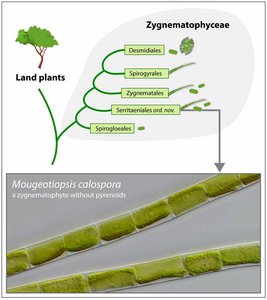An international team of scientists led jointly by the Universities of Göttingen and Cologne has deciphered the evolutionary history of zygnematophytes. Their results reveal the internal relationships in this group of algae using state-of-the-art phylogenomic analyses and pinpoint the emergences of algal multicellularity. The results have been published in the article ‘A phylogenomically informed five-order system for the closest relatives of land plants’ in the journal Current Biology.
Land plants are extremely diverse in terms of their structure and represent the most complex photosynthetic organisms. Their closest relatives, the ‘conjugating green algae’ (Zygnematophyceae), instead, have much simpler body plans. These algae are either unicellular or form unbranched filaments, which was traditionally used to roughly classify these algae in unicellular and filamentous taxa. The Zygnematophyceae encompass around 4,000 species and display a fascinating morphological diversity – from the beautiful desmids to filamentous species responsible for pond scum (Fig. 1). The scientific interest in this algal group is currently very high, because research in recent years has revealed that these algae are the closest relatives of land plants. The scientists were surprised about this finding as the zygnematophyte body plans are less complex than those of other algae, which before were erroneously considered to be the closest relatives of land plants. The fact that the Zygnematophyceae diverged from their last common ancestor with plants about 550 million years ago and since then charted their own evolutionary path might be the reason for this marked morphological split.
The team of researchers used hundreds of genes to collect tens of thousands of the molecular characters, which could be used to infer the deep relationships within the Zygnematophyceae (Fig. 2). ‘The taxonomy of these algae has been an unsolved problem for decades, as analyses with single or few genes did not have the power to resolve old evolutionary splits. Now we introduce a phylogenetically informed five-order system of the zygnematophytes, which will help scientists to navigate in the evolutionary diversity of these algae;’ said Dr Sebastian Hess (University of Cologne). Furthermore, the new dataset provided the basis for statistical analyses, which enabled the researchers to reconstruct the most likely pattern of body plan evolution in this important class of algae. These analyses suggest that the last common ancestor of the zygnematophytes was a single-celled alga and that filamentous growth emerged several times independently in these algae.
Professor Dr Jan de Vries (University of Göttingen) highlights: ‘The evolution of these algae had a profound impact on life on earth. Today’s land plants have elaborate multicellular bodies that constitute the vast majority of the biomass on land. Research into the closest algal relatives allows us to infer features such as the body plan of the last common ancestor shared by land plants and algae, and the evolutionary paths charted since their divergence.’
Another important part of the study was the rediscovery of Mougeotiopsis, a filamentous alga, which was originally described about 120 years ago and has not been studied since then (Fig. 2). This alga lacks pyrenoids, the chloroplast substructures aiding CO2 fixation during photosynthesis, and as the researchers demonstrate represents yet another evolutionary branch of the zygnematophytes that shows multicellular growth. Anna Busch (University of Cologne), who studied the alga using light microscopy, explained: ‘The phylogenetic position of Mougeotiopsis came as a big surprise. The filamentous alga is most closely related to simple, unicellular species and it has no pyrenoids. This is exceptional for all other known zygnematophytes.’ The evolutionary history of Mougeotiopsis marks one of the five emergences of true filamentous growth within the Zygnematophyceae. ‘Such insights and the new phylogenomic framework are fundamental for adequately performing future comparative analyses and for inferring the development of cellular traits and body plans from algae to plants,’ said de Vries.
Media Contact:
Dr. Sebastian Hess
Cologne Biocenter
+49 221 470 4013
sebastian.hess@uni-koeln.de
https://www.zoologie.uni-koeln.de/hess.html
Prof. Dr. Jan de Vries
Institut für Mikrobiologie und Genetik
Abteilung Angewandte Bioinformatik
Georg-August-Universität Göttingen
+49 551 39 23755
devries.januni-goettingen.de
www.uni-goettingen.de/de/613776.html
Presse und Kommunikation:
Robert Hahn
+49 221 470 3107
r.hahnverw.uni-koeln.de
Publication:
https://www.cell.com/current-biology/fulltext/S0960-9822(22)01299-4
